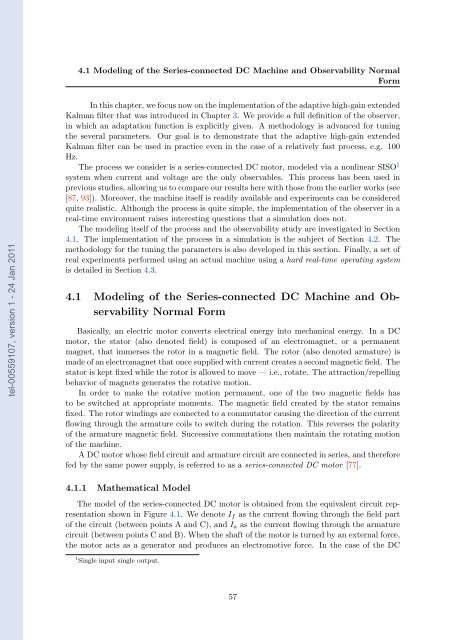Adaptative high-gain extended Kalman filter and applications
Adaptative high-gain extended Kalman filter and applications
Adaptative high-gain extended Kalman filter and applications
Create successful ePaper yourself
Turn your PDF publications into a flip-book with our unique Google optimized e-Paper software.
tel-00559107, version 1 - 24 Jan 2011<br />
4.1 Modeling of the Series-connected DC Machine <strong>and</strong> Observability Normal<br />
Form<br />
In this chapter, we focus now on the implementation of the adaptive <strong>high</strong>-<strong>gain</strong> <strong>extended</strong><br />
<strong>Kalman</strong> <strong>filter</strong> that was introduced in Chapter 3. We provide a full definition of the observer,<br />
in which an adaptation function is explicitly given. A methodology is advanced for tuning<br />
the several parameters. Our goal is to demonstrate that the adaptive <strong>high</strong>-<strong>gain</strong> <strong>extended</strong><br />
<strong>Kalman</strong> <strong>filter</strong> can be used in practice even in the case of a relatively fast process, e.g. 100<br />
Hz.<br />
The process we consider is a series-connected DC motor, modeled via a nonlinear SISO 1<br />
system when current <strong>and</strong> voltage are the only observables. This process has been used in<br />
previous studies, allowing us to compare our results here with those from the earlier works (see<br />
[87, 93]). Moreover, the machine itself is readily available <strong>and</strong> experiments can be considered<br />
quite realistic. Although the process is quite simple, the implementation of the observer in a<br />
real-time environment raises interesting questions that a simulation does not.<br />
The modeling itself of the process <strong>and</strong> the observability study are investigated in Section<br />
4.1. The implementation of the process in a simulation is the subject of Section 4.2. The<br />
methodology for the tuning the parameters is also developed in this section. Finally, a set of<br />
real experiments performed using an actual machine using a hard real-time operating system<br />
is detailed in Section 4.3.<br />
4.1 Modeling of the Series-connected DC Machine <strong>and</strong> Observability<br />
Normal Form<br />
Basically, an electric motor converts electrical energy into mechanical energy. In a DC<br />
motor, the stator (also denoted field) is composed of an electromagnet, or a permanent<br />
magnet, that immerses the rotor in a magnetic field. The rotor (also denoted armature) is<br />
made of an electromagnet that once supplied with current creates a second magnetic field. The<br />
stator is kept fixed while the rotor is allowed to move — i.e., rotate. The attraction/repelling<br />
behavior of magnets generates the rotative motion.<br />
In order to make the rotative motion permanent, one of the two magnetic fields has<br />
to be switched at appropriate moments. The magnetic field created by the stator remains<br />
fixed. The rotor windings are connected to a commutator causing the direction of the current<br />
flowing through the armature coils to switch during the rotation. This reverses the polarity<br />
of the armature magnetic field. Successive commutations then maintain the rotating motion<br />
of the machine.<br />
A DC motor whose field circuit <strong>and</strong> armature circuit are connected in series, <strong>and</strong> therefore<br />
fed by the same power supply, is referred to as a series-connected DC motor [77].<br />
4.1.1 Mathematical Model<br />
The model of the series-connected DC motor is obtained from the equivalent circuit representation<br />
shown in Figure 4.1. We denote If as the current flowing through the field part<br />
of the circuit (between points A <strong>and</strong> C), <strong>and</strong> Ia as the current flowing through the armature<br />
circuit (between points C <strong>and</strong> B). When the shaft of the motor is turned by an external force,<br />
the motor acts as a generator <strong>and</strong> produces an electromotive force. In the case of the DC<br />
1 Single input single output.<br />
57

















